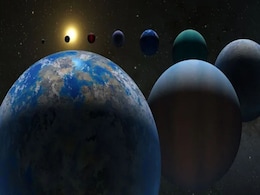Mars Atmosphere
- All
- News
- Videos
-

NASA Curiosity Rover Potentially Deciphers Mars’ Missing Carbonate Mystery
- Friday April 18, 2025
- Written by Gadgets 360 Staff
NASA’s Curiosity rover potentially ended the mystery of the ancient atmosphere and missing carbonates. The research uncovers the potential reasons behind the temperature of the planet Mars and how it has supported the liquid water on the planet. Explore the findings and the discoveries made by NASA’s Curiosity rover.
-
 www.gadgets360.com
www.gadgets360.com
-

"Crash Icy Asteroids Into Mars": Scientist's Plan To Make Mars Liveable For Humans
- Wednesday April 9, 2025
- Science | Edited by Nikhil Pandey
Dr Leszek Czechowski proposes a radical approach to terraform Mars by crashing asteroids into the planet.
-
 www.ndtv.com
www.ndtv.com
-

Curiosity Rover Finds Evidence of Liquid Water on Mars, Expanding Habitability Timeline
- Tuesday February 18, 2025
- Written by Gadgets 360 Staff
Reports from NASA’s Curiosity rover reveal evidence of ancient liquid water on Mars, challenging previous models. Images from Gale Crater show wave-like ripples, similar to Earth’s lakebeds. Scientists suggest the findings indicate Mars once had a denser atmosphere, which allowed liquid water to exist longer than previously believed. This disco...
-
 www.gadgets360.com
www.gadgets360.com
-

Curiosity Rover Observes Iridescent Clouds on Mars, Offering New Insights
- Friday February 14, 2025
- Written by Gadgets 360 Staff
NASA’s Curiosity rover has captured rare iridescent clouds drifting across the Martian sky, observed at high altitudes in twilight conditions. These carbon dioxide ice clouds were seen forming between 60 and 80 kilometres above the surface before evaporating as they descended. Scientists believe their presence hints at unknown cooling mechanisms ...
-
 www.gadgets360.com
www.gadgets360.com
-

NASA’s Curiosity Rover Captures Stunning Feather-Shaped Iridescent Cloud on Mars
- Friday February 14, 2025
- Written by Gadgets 360 Staff
A remarkable feather-shaped iridescent cloud was spotted by NASA’s Curiosity rover on Mars. Captured during a seasonal imaging campaign, this phenomenon provides valuable data on Martian weather patterns. Scientists believe such clouds help study particle sizes and atmospheric changes. The cloud, composed of either water ice or carbon dioxide ice...
-
 www.gadgets360.com
www.gadgets360.com
-

Newly Discovered Oxygen Reaction Existed in Primitive Atmosphere, Sheds Light on Origin of Life
- Saturday January 4, 2025
- Written by Gadgets 360 Staff
Scientists have uncovered a new way oxygen could form in carbon dioxide-rich atmospheres without the involvement of life. The discovery, led by researchers from the University of Science and Technology of China, shows that a reaction between helium ions and CO2 can produce molecular oxygen. This process challenges traditional methods of life detect...
-
 www.gadgets360.com
www.gadgets360.com
-

NASA's Curiosity Rover Explores Mars' Texoli Butte Amid New Challenges
- Wednesday December 18, 2024
- Written by Gadgets 360 Staff
NASA's Curiosity Rover is navigating the northern end of Texoli Butte on Mars, uncovering ancient sedimentary layers. Recent challenges forced the rover to stop its drive earlier than planned, delaying some imaging tasks. Despite this, scientific efforts continued, focusing on "Avalon," a dark bedrock vein, long-range imaging, and environmental obs...
-
 www.gadgets360.com
www.gadgets360.com
-

Mars Dust Storms May Be Predictable Based on Surface Heating Patterns
- Thursday December 12, 2024
- Written by Gadgets 360 Staff
A new study suggests warm days on Mars often precede dust storms, with researchers analysing data from NASA's Mars Reconnaissance Orbiter. The findings show 78% of storms correlate with increased solar heating, particularly in northern regions of the planet. Scientists have developed an algorithm predicting certain storm types with 64% confidence, ...
-
 www.gadgets360.com
www.gadgets360.com
-

Scientists Discover New Electric Field in Earth’s Atmosphere Crucial for Life
- Thursday November 14, 2024
- Written by Gadgets 360 Staff
Scientists have finally detected the long-predicted ambipolar electric field in Earth's atmosphere. Though weak, it plays a crucial role in shaping the planet’s upper atmosphere, impacting the polar wind and potentially contributing to Earth’s habitability. This discovery could help explain why Earth’s atmosphere has remained conducive to lif...
-
 www.gadgets360.com
www.gadgets360.com
-

New Atlas of Martian Clouds Reveals A Diverse Atmosphere
- Wednesday September 11, 2024
- Science | Edited by Anjali Thakur
Despite its thin atmosphere composed primarily of carbon dioxide, Mars can produce striking cloud formations when conditions are right,
-
 www.ndtv.com
www.ndtv.com
-

Mars Loses Water Faster When Closer to the Sun, New Hubble and MAVEN Study Shows
- Tuesday September 17, 2024
- Written by Gadgets 360 Staff
Mars loses water faster when it is closest to the Sun, according to new data from the Hubble Space Telescope and NASA’s Mars Atmosphere and Volatile Evolution (MAVEN) mission. The rate of hydrogen loss in Mars' atmosphere increases significantly during perihelion, the point in its orbit closest to the Sun. This seasonal change has major implicati...
-
 www.gadgets360.com
www.gadgets360.com
-

Debris From NASA Mission Could Create The First Human-Made Meteor Shower. Here's How
- Monday September 2, 2024
- Science | Edited by Ritu Singh
The collision between the asteroid Dimorphos and DART spacecraft generated a massive debris field, estimated to be around 2 million pounds of rocks and dust.
-
 www.ndtv.com
www.ndtv.com
-

Mars Colonisation: Why Explore The Red Planet And Can We Live There?
- Saturday May 18, 2024
- Feature | Edited by Bhavya Sukheja
US space agency NASA is hoping to land the first humans on Mars by the 2030s and SpaceX chief Elon Musk recently said that humans could be living in a city on the Red Planet in the next 30 years.
-
 www.ndtv.com
www.ndtv.com
-

Flying In Martian Sky, A NASA Chopper Made By An Indian
- Sunday October 29, 2023
- India News | Written by Pallava Bagla
US space agency NASA is flying an aircraft -- a helicopter capable of flying in alien atmosphere -- in Mars.
-
 www.ndtv.com
www.ndtv.com
-

NASA Curiosity Rover Potentially Deciphers Mars’ Missing Carbonate Mystery
- Friday April 18, 2025
- Written by Gadgets 360 Staff
NASA’s Curiosity rover potentially ended the mystery of the ancient atmosphere and missing carbonates. The research uncovers the potential reasons behind the temperature of the planet Mars and how it has supported the liquid water on the planet. Explore the findings and the discoveries made by NASA’s Curiosity rover.
-
 www.gadgets360.com
www.gadgets360.com
-

"Crash Icy Asteroids Into Mars": Scientist's Plan To Make Mars Liveable For Humans
- Wednesday April 9, 2025
- Science | Edited by Nikhil Pandey
Dr Leszek Czechowski proposes a radical approach to terraform Mars by crashing asteroids into the planet.
-
 www.ndtv.com
www.ndtv.com
-

Curiosity Rover Finds Evidence of Liquid Water on Mars, Expanding Habitability Timeline
- Tuesday February 18, 2025
- Written by Gadgets 360 Staff
Reports from NASA’s Curiosity rover reveal evidence of ancient liquid water on Mars, challenging previous models. Images from Gale Crater show wave-like ripples, similar to Earth’s lakebeds. Scientists suggest the findings indicate Mars once had a denser atmosphere, which allowed liquid water to exist longer than previously believed. This disco...
-
 www.gadgets360.com
www.gadgets360.com
-

Curiosity Rover Observes Iridescent Clouds on Mars, Offering New Insights
- Friday February 14, 2025
- Written by Gadgets 360 Staff
NASA’s Curiosity rover has captured rare iridescent clouds drifting across the Martian sky, observed at high altitudes in twilight conditions. These carbon dioxide ice clouds were seen forming between 60 and 80 kilometres above the surface before evaporating as they descended. Scientists believe their presence hints at unknown cooling mechanisms ...
-
 www.gadgets360.com
www.gadgets360.com
-

NASA’s Curiosity Rover Captures Stunning Feather-Shaped Iridescent Cloud on Mars
- Friday February 14, 2025
- Written by Gadgets 360 Staff
A remarkable feather-shaped iridescent cloud was spotted by NASA’s Curiosity rover on Mars. Captured during a seasonal imaging campaign, this phenomenon provides valuable data on Martian weather patterns. Scientists believe such clouds help study particle sizes and atmospheric changes. The cloud, composed of either water ice or carbon dioxide ice...
-
 www.gadgets360.com
www.gadgets360.com
-

Newly Discovered Oxygen Reaction Existed in Primitive Atmosphere, Sheds Light on Origin of Life
- Saturday January 4, 2025
- Written by Gadgets 360 Staff
Scientists have uncovered a new way oxygen could form in carbon dioxide-rich atmospheres without the involvement of life. The discovery, led by researchers from the University of Science and Technology of China, shows that a reaction between helium ions and CO2 can produce molecular oxygen. This process challenges traditional methods of life detect...
-
 www.gadgets360.com
www.gadgets360.com
-

NASA's Curiosity Rover Explores Mars' Texoli Butte Amid New Challenges
- Wednesday December 18, 2024
- Written by Gadgets 360 Staff
NASA's Curiosity Rover is navigating the northern end of Texoli Butte on Mars, uncovering ancient sedimentary layers. Recent challenges forced the rover to stop its drive earlier than planned, delaying some imaging tasks. Despite this, scientific efforts continued, focusing on "Avalon," a dark bedrock vein, long-range imaging, and environmental obs...
-
 www.gadgets360.com
www.gadgets360.com
-

Mars Dust Storms May Be Predictable Based on Surface Heating Patterns
- Thursday December 12, 2024
- Written by Gadgets 360 Staff
A new study suggests warm days on Mars often precede dust storms, with researchers analysing data from NASA's Mars Reconnaissance Orbiter. The findings show 78% of storms correlate with increased solar heating, particularly in northern regions of the planet. Scientists have developed an algorithm predicting certain storm types with 64% confidence, ...
-
 www.gadgets360.com
www.gadgets360.com
-

Scientists Discover New Electric Field in Earth’s Atmosphere Crucial for Life
- Thursday November 14, 2024
- Written by Gadgets 360 Staff
Scientists have finally detected the long-predicted ambipolar electric field in Earth's atmosphere. Though weak, it plays a crucial role in shaping the planet’s upper atmosphere, impacting the polar wind and potentially contributing to Earth’s habitability. This discovery could help explain why Earth’s atmosphere has remained conducive to lif...
-
 www.gadgets360.com
www.gadgets360.com
-

New Atlas of Martian Clouds Reveals A Diverse Atmosphere
- Wednesday September 11, 2024
- Science | Edited by Anjali Thakur
Despite its thin atmosphere composed primarily of carbon dioxide, Mars can produce striking cloud formations when conditions are right,
-
 www.ndtv.com
www.ndtv.com
-

Mars Loses Water Faster When Closer to the Sun, New Hubble and MAVEN Study Shows
- Tuesday September 17, 2024
- Written by Gadgets 360 Staff
Mars loses water faster when it is closest to the Sun, according to new data from the Hubble Space Telescope and NASA’s Mars Atmosphere and Volatile Evolution (MAVEN) mission. The rate of hydrogen loss in Mars' atmosphere increases significantly during perihelion, the point in its orbit closest to the Sun. This seasonal change has major implicati...
-
 www.gadgets360.com
www.gadgets360.com
-

Debris From NASA Mission Could Create The First Human-Made Meteor Shower. Here's How
- Monday September 2, 2024
- Science | Edited by Ritu Singh
The collision between the asteroid Dimorphos and DART spacecraft generated a massive debris field, estimated to be around 2 million pounds of rocks and dust.
-
 www.ndtv.com
www.ndtv.com
-

Mars Colonisation: Why Explore The Red Planet And Can We Live There?
- Saturday May 18, 2024
- Feature | Edited by Bhavya Sukheja
US space agency NASA is hoping to land the first humans on Mars by the 2030s and SpaceX chief Elon Musk recently said that humans could be living in a city on the Red Planet in the next 30 years.
-
 www.ndtv.com
www.ndtv.com
-

Flying In Martian Sky, A NASA Chopper Made By An Indian
- Sunday October 29, 2023
- India News | Written by Pallava Bagla
US space agency NASA is flying an aircraft -- a helicopter capable of flying in alien atmosphere -- in Mars.
-
 www.ndtv.com
www.ndtv.com





















